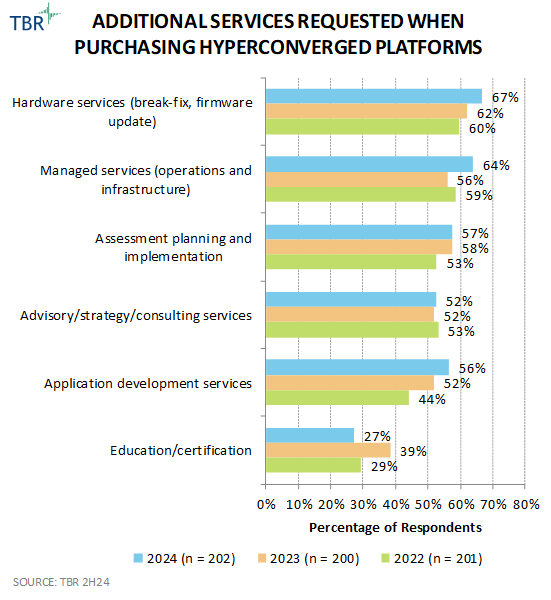2H24 Hyperconverged Platforms Customer Research
TBR Spotlight Reports represent an excerpt of TBR’s full subscription research. Full reports and the complete data sets that underpin benchmarks, market forecasts and ecosystem reports are available as part of TBR’s subscription service. Click here to receive all new Spotlight Reports in your inbox.
Turmoil over VMware’s licensing changes for VCF could cause customers to shift to other hyperconverged platforms or even to move away from HCI altogether and toward public cloud
Artificial intelligence
Although AI has been part of HCI workloads for some time, industry hype has brought more attention to both AI-enabled workloads and AI running as its own workload. Respondents cited AI as the top workload being run on HCI, and indicated AI is enabling a number of other workloads, including database management, business intelligence/ analytics, business apps (CRM, ERP), data backup, disaster recovery and IoT.
When it comes to generative AI (GenAI), the majority of the respondents’ organizations had already implemented GenAI into some of their business workflows or are evaluating how to do this. Organizations face different adoption challenges depending on their size. For example, large enterprises look for solutions that ensure data privacy and accuracy of results, while smaller organizations consider cost, skill set needed to operate the solution and how data must be structured.
Hybrid cloud
Nearly 70% of respondents are utilizing HCI for hybrid cloud, and HCI vendors continue to roll out enhancements to their hybrid cloud offerings with partners such as Microsoft Azure, VMware, Nutanix and Red Hat. At the same time, complex integration with existing infrastructure was the top challenge respondents faced with HCI rollouts in 2024. Additionally, 26% of respondents indicated they have not yet realized the benefits of integrating their HCI into a hybrid cloud. As HCI systems are increasingly becoming the foundation for numerous hybrid cloud and edge computing solutions, vendors must be prepared to simplify and enable system deployment, becoming more complex due to integrations with other systems and platforms.
VMware
VMware’s licensing changes for VMware Cloud Foundation (VCF) and other software have created significant upheaval among customers, with over half of respondents surveyed indicating they are exploring alternatives. While this may create opportunities for competing HCI solutions, such as Azure Stack HCI or Nutanix Cloud Infrastructure, customers frustrated with licensing fees may also choose to shift HCI workloads to a public cloud alternative instead of to another on-premises solution.
While the rate of on-premises data center consolidation has declined for 2 consecutive years, the rate of data center expansion has increased
Over the past two years, the percentage of respondents who are significantly consolidating their on-premises data center space has decreased from 53% in 2022 to 40% in 2024. At the same time, the percentage of respondents who are significantly increasing their on-premises data center footprints has grown from 4% in 2022 to 13% in 2024.
Overall, data center consolidation is still the prevailing trend, with 66% of respondents somewhat or significantly consolidating their on-premises data center space. However, respondents are trending toward more of a middle ground, which is likely driven by a combination of factors including hybrid cloud adoption, workload placement optimization, cloud repatriation and upgrading older data center infrastructure to denser systems.

HCI customer respondents’ managed services uptake increased approximately 5% in 2024 compared to 2023
Hardware services such as break-fix and firmware update continue to be the most commonly attached services to purchases of hyperconverged platforms, while managed services ranks a close second.
Vendors continue to leverage “as a Service” offerings to drive increased services attach on hyperconverged platform sales. As customers increasingly opt in to managed services contracts, education and certification services attach has fallen.
Consumption of assessment planning and implementation services as well as advisory, strategy and consulting services remained largely flat on a year-to-year basis in 2024, demonstrating consistent demand for such offerings as customers continue to seek support in evaluating new use cases.
As organizations’ data volumes continue to increase, respondents expect to leverage HCI more heavily, taking advantage of the highly scalable nature of these platforms
Data backup and disaster recovery was the second most common workload respondents reported running on their hyperconverged infrastructure, and the top workload customers plan to move to hyperconverged platforms.
While DevOps was ranked No. 8 in overall workload adoption on HCI, respondents have identified it as a future growth area as the second most popular workload expected to be moved to hyperconverged platforms.

 Technology Business Research, Inc.
Technology Business Research, Inc.
 Technology Business Research, Inc.
Technology Business Research, Inc.